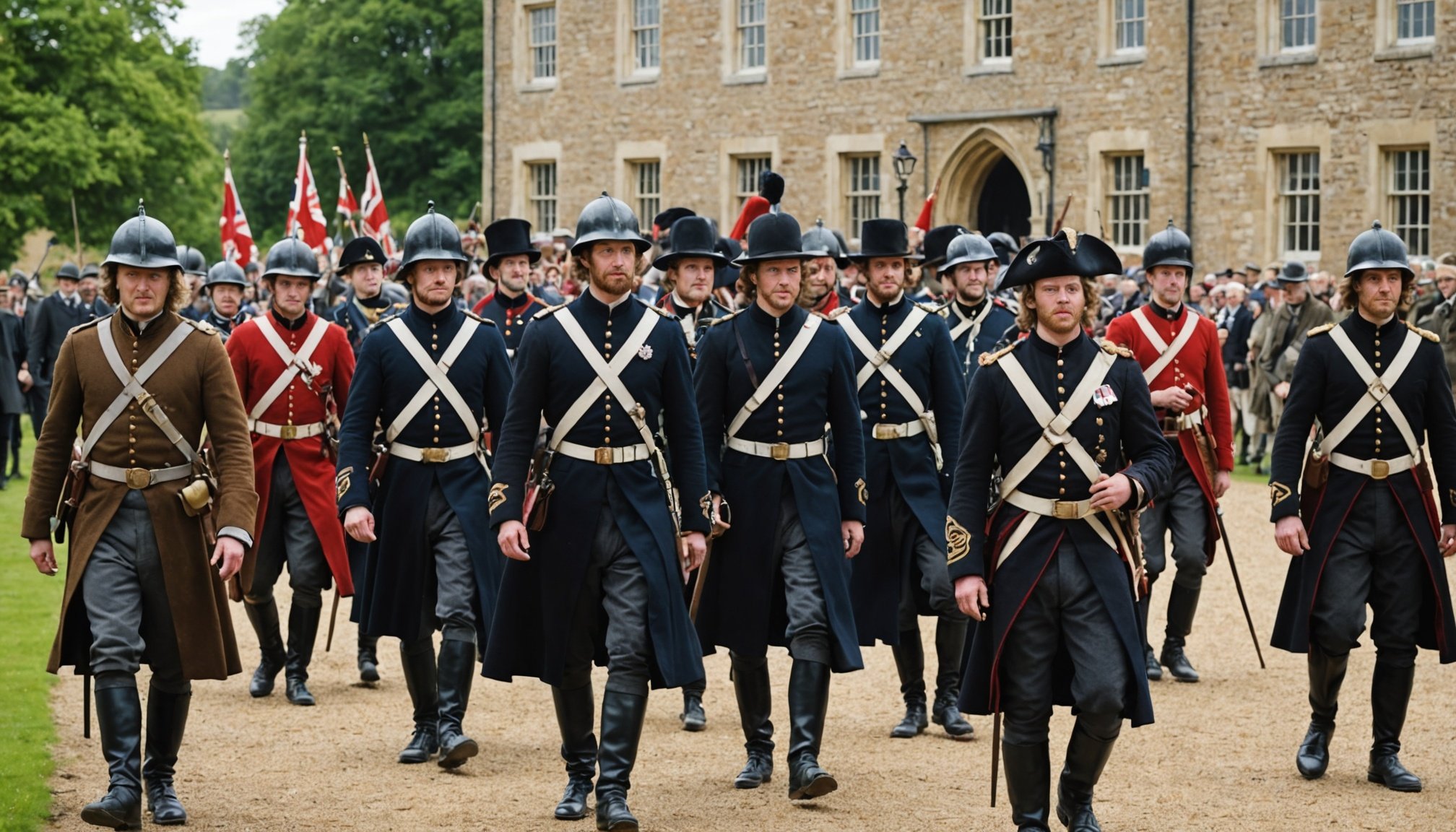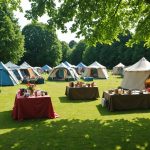Overview of Historical Reenactments in the UK
Historical reenactments have become a popular way to engage with the past in the UK, allowing enthusiasts to relive significant events and experience history firsthand. These reenactments are dramatic recreations of historical periods, often staged at the actual locations where the events took place.
In the UK, several historical periods are particularly popular for reenactments. The medieval era, with its knights and castles, the Victorian times, and events from the World Wars are frequently revisited. These reenactments not only provide entertainment but also offer educational insights, illustrating historical life authentically. Such events enable participants and spectators to grasp the immediate social and cultural aspects of these periods.
Additional reading : Explore the Wonders of the Peak District: Join a Guided Photography Tour of Stunning Natural Landscapes!
Audience engagement is a cornerstone of historical reenactments. These events invite spectators to step into history – whether by dressing in period costumes, joining in battle simulations, or participating in historical workshops. This balanced mix of education and engagement ensures these gatherings are both enjoyable and informative. The blend of interactive sessions, storytelling, and displays makes historical reenactments a celebrated cultural phenomenon in the UK. Attendees often leave with a greater appreciation for the rich tapestry of history, sparked by engaging depictions of eras gone by.
Types of Historical Reenactment Events
Historical reenactments offer a captivating glimpse into the past, allowing participants to experience different eras. They can range from grand exhibits to detailed battleground simulations.
Have you seen this : Immerse Yourself in Authentic British Baking: Join a Workshop in Charming Rural England!
Medieval Reenactments
Medieval reenactments plunge enthusiasts into the life and times of the Middle Ages. UK history is rich with events such as jousts, fairs, and battles. Participants recreate the splendor of these times with vibrant costumes and dramatic tournaments. Key events often focus on famous battles such as the Battle of Hastings. Groups like the Medieval Combat Society animate these spectacles with authenticity and enthusiasm, embracing both educational and entertaining facets.
Civil War Reenactments
Civil War reenactments often centre around the turbulent times of the English Civil War. Events capture the clash between Royalists and Parliamentarians, bringing history to life at sites across Britain. The Sealed Knot is a notable reenactment group committed to sharing the historical context and significance of these events. Through accurate portrayals, they honour the sacrifices made during this defining period in UK history.
World War II Reenactments
World War II reenactments depict one of the most profound periods in recent history. These events are filled with tributes to the men and women who witnessed and shaped this era. Often, they reenact pivotal skirmishes or evocative home-front scenes. The World War II Living History Association leads such activities, creating a dynamic connection to the past by showcasing vintage equipment, uniforms, and rare memorabilia.
How to Get Involved in Reenactments
Getting involved in historical reenactments can be a fulfilling way to immerse oneself in history. The initial steps often involve contacting local reenactment groups. These groups usually provide a welcoming environment for newcomers and can guide you on how to participate effectively.
Researching local groups and events is crucial. By identifying active local reenactment communities, you can find those that align with your historical interest, be it the Civil War or medieval times. Online platforms, social media, and community boards are excellent resources to discover active gatherings and events near you.
Once you’ve pinpointed a group, focus on building connections. Engagement with experienced participants is immensely beneficial. Seasoned reenactors can offer insights into the hobby’s nuances—from where to find authentic costumes to understanding event etiquette. It’s wise to attend a few events as a spectator first. This gives you a sense of the environment and performance expectations.
Consider volunteer opportunities to kick-start your journey. Volunteering can provide behind-the-scenes experience and allows you to learn more about the organization of events. By volunteering, you may find a niche, whether that’s crafting period-specific clothing or participating in battle reenactments. Engaging authentically with the community over time helps to establish credibility and ensures an enriching experience in historical reenactments.
Requirements for Participants
Participants in historical reenactments must be aware of specific requirements, particularly concerning reenactment gear. This is crucial for ensuring a realistic portrayal, especially when different types of reenactments are considered, such as medieval, colonial, or Civil War events.
Gear and Costumes
For each reenactment style, appropriate costumes and gear are essential. Participants must research the era they will portray and gather or create attire that closely reflects the time period’s fashion and utility items. This includes clothing like coats, hats, and footwear, as well as accessories such as belts, bags, and weapons, if applicable. Reenactors often find themselves thoroughly engaged in sourcing these historically accurate items, sometimes from specialty stores or through crafting them manually.
Historical Accuracy
Historical accuracy is paramount in reenactments as it honors the integrity of the event and the period it represents. Accurate gear and costumes allow participants to contribute meaningfully to the recreative experience. This adherence to authenticity not only enhances the audience’s understanding but also fulfills the participant’s role more convincingly.
Safety Requirements
Safety regulations are equally important. Reenactments often have a set of protocols to ensure participants’ well-being, especially when involving weapons or heavy equipment. Participants should familiarize themselves with safety guidelines, such as those relating to combat reenactments, where safe handling and engagement rules are strictly enforced to prevent injuries. This includes performing drills and checks of all props and equipment. This approach guarantees a respectful and secure environment for both participants and spectators alike.
Tips for First-Time Participants
Embarking on your first historical reenactment can feel daunting, but with some preparation, it can be an enjoyable adventure. Here’s how you can confidently approach your first-time experience.
Event Preparation
Thorough preparation is vital for first-time participants. Begin by researching the historical period you’re interested in; understanding its broad context will enrich your experience. Consider creating a checklist that includes items like costume essentials, event schedules, and necessary equipment. Remember to verify the event requirements, as some may have specific guidelines regarding attire or behaviour.
Interacting with Fellow Participants
When attending your first reenactment event, it’s important to approach others with respect and enthusiasm. While it’s natural to be curious, remember that reenactors are deeply passionate about their roles. Engaging in conversations by asking insightful questions shows interest while allowing you to learn from more seasoned participants.
Common Misconceptions
There are common misconceptions about reenactments that can deter beginners. Contrary to belief, not all events demand perfection in historical accuracy. Focus on enjoying the experience and gradually building your knowledge. Success lies in the authenticity of your enthusiasm rather than perfect depiction. Additionally, don’t shy away from seeking guidance from experts; they’re often eager to help newcomers.
With these tips in your arsenal, you can confidently navigate your first reenactment and fully immerse yourself in the event.
Costs Involved in Reenactments
The reenactment costs can vary significantly, influencing both new and seasoned participants. Initial expenses often include costumes and accessories, crucial for authenticity. These items can range from handmade attire to detailed replicas from specialised suppliers, sometimes demanding a substantial investment.
Budgeting for an event also involves considering participant or entry fees, which cover event logistics, like location rental and permits. While these can add to financial considerations, some events might offer discounts for early registration or group participation, which is a beneficial strategy for saving.
For those concerned about expenses, there are options to participate in reenactments without breaking the bank. Budget-friendly strategies include crafting costumes at home using readily available materials or purchasing secondhand attire, which can significantly reduce costs while maintaining quality. Many participants find swapping or borrowing pieces from other members of reenactment groups a clever way to manage expenses creatively.
For financial assistance, consider seeking sponsorship from local businesses interested in supporting historical events or exploring grants from organisations that promote cultural heritage. Communities also often have resources and forums where members share tips on cost-saving and coordinate group purchases, which can further alleviate financial burdens. By taking advantage of these resources, anyone can participate in reenactments without undue financial strain.
Resources and Community Groups
Finding and joining reenactment resources can greatly enhance your participation in historical events. In the UK, several prominent reenactment groups are open to newcomers and enthusiasts alike. These groups, such as the Sealed Knot and the English Civil War Society, offer structured events and community gatherings that allow members to immerse themselves in historical periods authentically.
Making community connections is easier than ever with the availability of online forums and social media platforms. These digital spaces are excellent for staying updated on upcoming events, exchanging tips, and fostering friendships with fellow reenactors. Facebook groups and specialized forums are particularly useful for sharing experiences and finding answers to common questions about gear, authenticity, and event logistics.
For those keen on deepening their engagement, a wealth of educational resources and workshops are available. These resources often include seminars on historical techniques, costume-making workshops, and guided tours of historical sites. By participating in these activities, reenactors can gain a more nuanced appreciation of the historical periods they portray, further enriching their reenactment experience.
Connecting with historical societies can also be beneficial. These societies often have extensive archives and expert historians who can provide detailed insights and guidance to enhance your portrayal and understanding of history. Engaging with these resources ensures a more informed and authentic reenactment.
Testimonials and Personal Experiences
Delving into the firsthand accounts of historical reenactors reveals a tapestry of vivid and impactful stories. These participant stories provide a window into the transformative nature of historical reenactments. Reenactors frequently express that engaging in these activities fosters a deeper historical understanding, connecting them with the past in immersive ways.
Many reenactors cite the benefits gained from donning period attire and living as people from bygone eras. These experiences are not only educational but also promote a profound personal growth and self-discovery. Participants often mention the joy of community engagement, meeting like-minded individuals who share a passion for history.
For Jane, a Civil War reenactor, the experience transformed her perception of history. “Walking in the shoes of those individuals made history come alive in a way books never could,” she shares. Such experiences exemplify how reenactments serve not only as an educational tool but also as a source of camaraderie and shared interest. Dave, another reenactor focused on medieval times, mentioned forming lifelong friendships through this shared passion.
Reenactments foster community by bringing together diverse groups united by a common interest. This sense of fellowship is enriched by the collective goal of preserving and celebrating history’s narratives, ensuring they remain alive for future generations.











